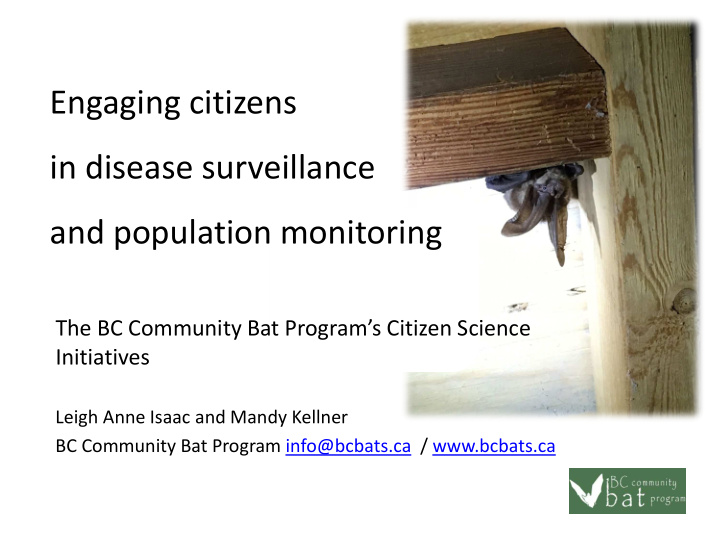



Engaging citizens in disease surveillance and population monitoring The BC Community Bat Program’s Citizen Science Initiatives Leigh Anne Isaac and Mandy Kellner BC Community Bat Program info@bcbats.ca / www.bcbats.ca
White-nose syndrome • Devastating fungal disease • 3 bat species Endangered in Canada to-date • 2016 – WNS made an unexpected jump to western North America
Bats are difficult • Difficult to locate, survey, monitor o Nocturnal – so we don’t see them o Flying – no tracks to survey o Ultrasonic frequencies for echolocation - we generally don’t hear them o Secretive - often roost in tight inaccessible spaces (soffits, roof flashing) o Similar-looking - species are often indistinguishable even to bat biologists o BC bats – do not hibernate in large, easy to count caves • How to do disease surveillance? How to monitor populations?
A network of regional bat projects across BC Four approaches to promote bat conservation: 1. Detection and protection of bat roosts in anthropogenic structures through a public education, targeted information solicitation and reporting program called “Got Bats?” 2. Education to counter negative attitudes towards bats 3. Conduct the Annual Bat Count , a Citizen Science program to provide baseline population data and engage landowners 4. Enhance bat habitat in human-altered landscapes, primarily through installation and monitoring of bat-houses CBP works with many regional stewardship and conservation organizations.
BC Community Bat Program and WNS surveillance efforts • BC CBP network is able to utilize our large network of partners to assist in surveillance efforts o regional partners (e.g., Habitat Acquisition Trust, Kootenay Community Bat Program, BC Parks) o regional coordinators o landowners o volunteers
Current surveillance and monitoring efforts 1. Annual Bat Count – the only province-wide roost monitoring program 2. Winter surveillance – dead bats and unusual activity (November - May) 3. Spring guano sampling (April - June)
Annual Bat Count • Kootenay Community Bat Program initiated in 2012; now across BC • Purpose o to identify and monitor colonies and detect declines due to WNS o encourage stewardship by Regional Coordinators and Volunteers • Visual exit counts at bat roosts in anthropogenic structures • Ideally 2 counts before pupping (June) and 2 after pupping (July/August)
Annual Bat Count • Modelled on the UK National Bat Monitoring Program – most species : 5 – 9 years of counts at 100 sites to detect population changes of 5% per year • We will likely be looking at a much larger decline • 30 – 99 % yearly after WNS arrived • No problem seeing decline in eastern Canada – no statistics necessary, many fewer sites need to be monitored • Detecting recovery will be challenging • Recovery will likely be slow; many sites needed to detect small changes
ABC: # of sites to 2017 Year Sites Counts 2012 10 26 2013 31 82 2014 44 113 2015 75 201 2016 152 396 2017 142 470 Total 257 1288
ABC: sampling sites
ABC: # of years of monitoring Number of Years Counted Number of Sites % of Total 1 156 61 2 45 17 3 32 12 4 9 4 5 14 5 6 1 1 Total 257 100
ABC: species detected • More than one Little Brown 46% Long-eared, species can occupy Long-legged 1% the same roost site Townsend's 4% • 46 % (92/198) of roosts are confirmed California to have Little Brown 7% Myotis Big Brown Yuma 7% 34%
Trends at Annual Bat Count sites
ABC: Citizen Scientist involvement • 2017 : 470 counts at 142 sites across the province • Impossible without volunteer involvement • Regional coordinators work with naturalist groups, community groups, and keen individuals • Volunteers participated in a minimum of 90 % (418 /470) of counts.
Winter WNS surveillance • Public reporting and submission of dead bats for testing: o 32 in 2017 o 7 from Jan – Mar 2018, more expected. • Small sample size
Spring guano for WNS surveillance • Guano sampling protocol: o Prep sites in early spring o Allow guano to accumulate for ~ 28 days o Collect and submit to FLNRO • Will increase sample size in the surveillance program • Targets roosts counted in ABC • Relies in part on Citizen Science roost stewards and volunteers • Year 1 is underway
Benefits of the citizen science approach for WNS surveillance • Wide-spread: extensive coverage across BC • Increased sample sizes: public involvement in surveillance and sample collection extends the sampling program beyond what paid biologists could achieve • Positive benefits to bats: public engagement and education about bats should ultimately contribute to bat conservation
Thank-you! • Province of BC – particularly O. Dyer, H. Schwantje, P. Govindarajulu, S. Willmott, and C. Nelson • Glenna MacGregor of the CWHC lab in Abbotsford • Our many regional coordinators and volunteers • BCCF – K. Calon • Our primary funders and many regional partners Contact the BC Community Bat Program Email: info@bcbats.ca Phone: 1-855-922-2287 Web: www.bcbats.ca Facebook: www.facebook.com/bcbats
Recommend
More recommend